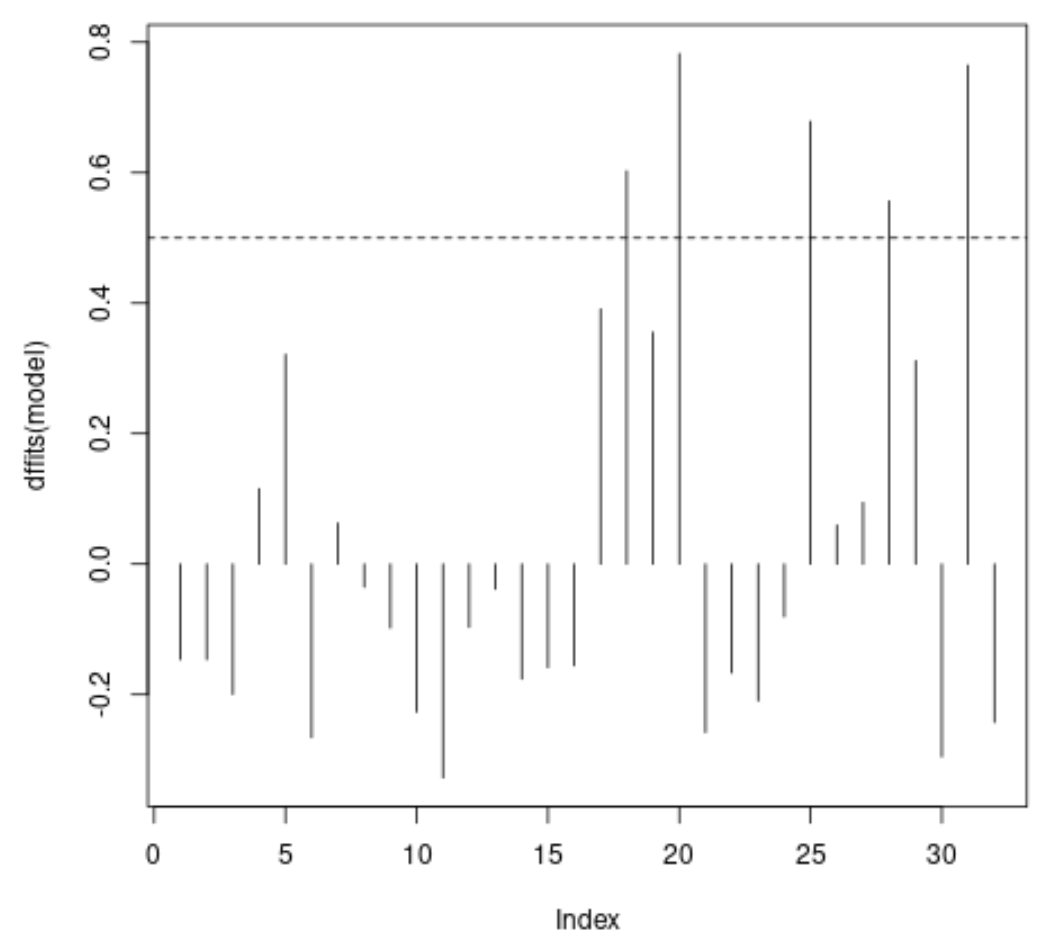In statistics, we often want to know how influential different observations are in regression models.
One way to calculate the influence of observations is by using a metric known as DFFITS, which stands for “difference in fits.”
This metric tells us how much the predictions made by a regression model change when we leave out an individual observation.
This tutorial shows a step-by-step example of how to calculate and visualize DFFITS for each observation in a model in R.
Step 1: Build a Regression Model
First, we’ll build a multiple linear regression model using the built-in mtcars dataset in R:
#load the dataset data(mtcars) #fit a regression model model #view model summary summary(model) Coefficients: Estimate Std. Error t value Pr(>|t|) (Intercept) 30.735904 1.331566 23.083
Step 2: Calculate DFFITS for each Observation
Next, we’ll use the built-in dffits() function to calculate the DFFITS value for each observation in the model:
#calculate DFFITS for each observation in the model dffits as.data.frame(dffits(model)) #display DFFITS for each observation dffits dffits(model) Mazda RX4 -0.14633456 Mazda RX4 Wag -0.14633456 Datsun 710 -0.19956440 Hornet 4 Drive 0.11540062 Hornet Sportabout 0.32140303 Valiant -0.26586716 Duster 360 0.06282342 Merc 240D -0.03521572 Merc 230 -0.09780612 Merc 280 -0.22680622 Merc 280C -0.32763355 Merc 450SE -0.09682952 Merc 450SL -0.03841129 Merc 450SLC -0.17618948 Cadillac Fleetwood -0.15860270 Lincoln Continental -0.15567627 Chrysler Imperial 0.39098449 Fiat 128 0.60265798 Honda Civic 0.35544919 Toyota Corolla 0.78230167 Toyota Corona -0.25804885 Dodge Challenger -0.16674639 AMC Javelin -0.20965432 Camaro Z28 -0.08062828 Pontiac Firebird 0.67858692 Fiat X1-9 0.05951528 Porsche 914-2 0.09453310 Lotus Europa 0.55650363 Ford Pantera L 0.31169050 Ferrari Dino -0.29539098 Maserati Bora 0.76464932 Volvo 142E -0.24266054
Typically we take a closer look at observations that have DFFITS values greater than a threshold of 2√p/n where:
- p: Number of predictor variables used in the model
- n: Number of observations used in the model
In this example, the threshold would be 0.5:
#find number of predictors in model p length(model$coefficients)-1 #find number of observations n nrow(mtcars) #calculate DFFITS threshold value thresh sqrt(p/n) thresh [1] 0.5
We can sort the observations based on their DFFITS values to see if any of them exceed the threshold:
#sort observations by DFFITS, descending dffits[order(-dffits['dffits(model)']), ] [1] 0.78230167 0.76464932 0.67858692 0.60265798 0.55650363 0.39098449 [7] 0.35544919 0.32140303 0.31169050 0.11540062 0.09453310 0.06282342 [13] 0.05951528 -0.03521572 -0.03841129 -0.08062828 -0.09682952 -0.09780612 [19] -0.14633456 -0.14633456 -0.15567627 -0.15860270 -0.16674639 -0.17618948 [25] -0.19956440 -0.20965432 -0.22680622 -0.24266054 -0.25804885 -0.26586716 [31] -0.29539098 -0.32763355
We can see that the first five observations have a DFFITS value greater than 0.5, which means we may want to investigate these observations closer to determine if they’re highly influential in the model.
Step 3: Visualize the DFFITS for each Observation
Lastly, we can create a quick plot to visualize the DFFITS for each observation:
#plot DFFITS values for each observation plot(dffits(model), type = 'h') #add horizontal lines at absolute values for threshold abline(h = thresh, lty = 2) abline(h = -thresh, lty = 2)
The x-axis displays the index of each observation in the dataset and the y-value displays the corresponding DFFITS value for each observation.
Additional Resources
How to Perform Simple Linear Regression in R
How to Perform Multiple Linear Regression in R
How to Calculate Leverage Statistics in R
How to Create a Residual Plot in R



